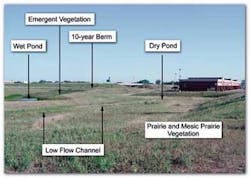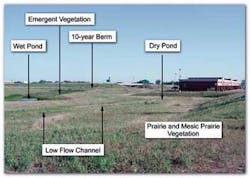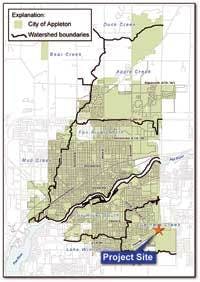Collaborative Effort, BMPs Help Project Exceed Target Goals
The City of Appleton in northeastern Wisconsin - as with many Wisconsin communities - must meet Wisconsin’s non-point pollution reduction performance standards contained in section NR 151 of the Wisconsin Administrative Code. These stormwater regulations, which took effect Oct. 1, 2004, effectively aligned Wisconsin’s administrative code (NR 216) and municipalities with the U.S. EPA’s Phase 2 stormwater requirements to reduce non-agricultural non-point pollutants.
NR 151 requires that, before discharging stormwater into a navigable stream from new development, cities must 1) reduce Total Suspended Solids (TSS) load by 80 percent, 2) reduce peak runoff to pre-development conditions for the 2-year, 24-hour design storm, and 3) include infiltration where soils allow.
In addition, NR 151 requires a 40 percent reduction in citywide TSS, as compared to the TSS generated without any site controls.
The complex nature of the multiple regulations and the involvement of regulatory bodies at the city, county, state and federal level makes Appleton’s comprehensive stormwater planning and treatment program a challenging task.
Strategy
In anticipation of development, the city acquired the Southpoint Commerce Park project site in the late 1990s to improve runoff quality and reduce peak discharges from a 402-acre watershed before the flow leaves the city. The city’s stormwater management policy at the time promoted the reduction of post-development flows to pre-settlement levels and an 80 percent reduction in TSS based upon existing WDNR guidelines.
At the time of pond construction, the tributary watershed contained:
• Areas of existing urban development requiring 40% TSS removal
• Areas of future development requiring 80% TSS removal
As the City of Appleton, led by Public Works Director Paula Vandehey, P.E., and Project Managers Susan Olson, P.E.; and Peter Neuberger, P.E., started the task of modeling, designing and constructing its regional stormwater facility, it enlisted the help of Earth Tech Inc. Together, the team designed a series of detention ponds in the Southpoint Commerce Park that used naturalized channels, native plantings, and wet and dry stormwater detention ponds that store and treat stormwater.
Other regulatory issues at the site further complicated matters - requiring relocation of a navigable stream, floodplain management, modifying wetlands, and zoning of shoreland and wetland.
Because the project site contained an intermittent, navigable stream - best described as a farmer’s drainage ditch - and a 0.3-acre jurisdictional wetland, the original concept plan consisted of an online wet detention pond along the navigable stream. However, the new NR 151 regulation required the treatment of urban stormwater before discharging into a navigable stream, effectively eliminating the possibility of an online pond.
The City of Appleton decided to build a wet pond parallel to the navigable stream that collects runoff from the local tributary area and treats that runoff before discharging into a dry pond associated with the relocated navigable stream. A second wet pond, a half-mile south of the dry pond, treats runoff from upstream areas.
The City of Appleton also created a spirit of project collaboration by proactively engaging in regular discussions with WDNR and regulatory agencies from federal, state, county and local levels. These discussions provided a number of benefits and helped the project team:
• Obtain unofficial agency input and buy-in before the permit documents were submitted
• Modify wetland and prairie plantings to address resource concerns
• Allow permits to be issued with minimal schedule impact
Implementation
To meet its complex regulatory requirements, the City of Appleton designed and constructed a series of stormwater structures, as follows:
Wet Pond - Today, local low runoff flows through the wet pond prior to discharging into the dry pond. A 10-inch diameter pipe and a 20-foot weir control storm events between the dry pond and the wet pond from the 2.3-inch, 2-year, 24-hour storm event up through the 3.8-inch, 10-year, 24-hour storm event. Larger storm events overtop the berm separating the ponds, taking advantage of the active storage above the 10-year berm elevation in both ponds. The outlet structure from the combined ponds regulates the 5.3-inch, 100-year, 24-hour event. The outlet structure uses an 18-inch diameter pipe and 6-foot-long weir, which discharges into a concrete drop structure and 36-inch-diameter outlet pipe. A composite weir carries a portion of the 100-year, 24-hour event, and larger storm event flows from the pond to the four box culverts beneath the nearby (state highway 441) exit ramp.
Dry Pond - The dry detention basin, with the relocated low-flow channel (classified as a navigable stream) that replaced the pre-project navigable stream, contains additional storage. The new naturalized channel increased the length of the navigable stream from 920 feet to 1,040 feet because of additional meanders in the realigned channel. Features along the relocated low-flow channel that now emulate a natural stream section are:
• Concave meanders with floodplain terraces that soften the look of the channel
• Undulating floodplains that mimic natural floodplains
• Native prairie and mesic prairie vegetation
• Pool structures and riffles that are typical of local, natural streams
In addition, the relocated stream design also included a more natural look with a composite channel cross section. The addition of meanders and pool/riffle structures in the streambed allowed for increased aquatic and riparian habitat.
New Wetlands - The low value wetlands associated with the intermittent, navigable stream were replaced with 0.65-acres of new wetlands, comprised of 0.19 acres of emergent vegetation on the wet pond’s safety shelf and 0.46 acres along the relocated navigable stream.
About the Authors:
Randolph Videkovich, PE, PH, is Director of Midwestern Water Resources for Earth Tech Inc. in Milwaukee, WI. Kelly Mattfield, PE, is a Senior Water Resources Engineer for Earth Tech in Madison, WI. Earth Tech Inc., a business unit of Tyco International Ltd., provides a full suite of engineering, construction and operations services to the international water/wastewater, environmental, transportation, and facilities markets.



